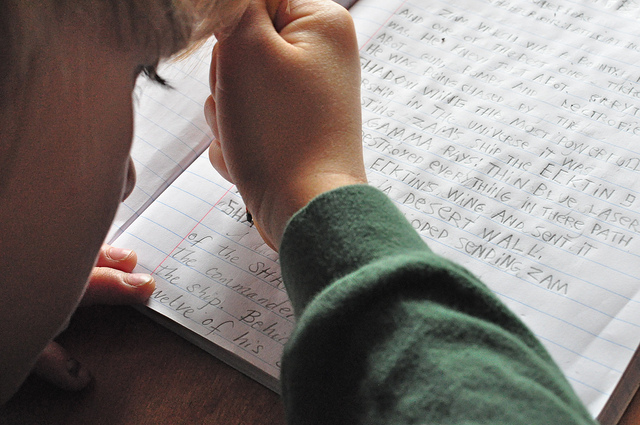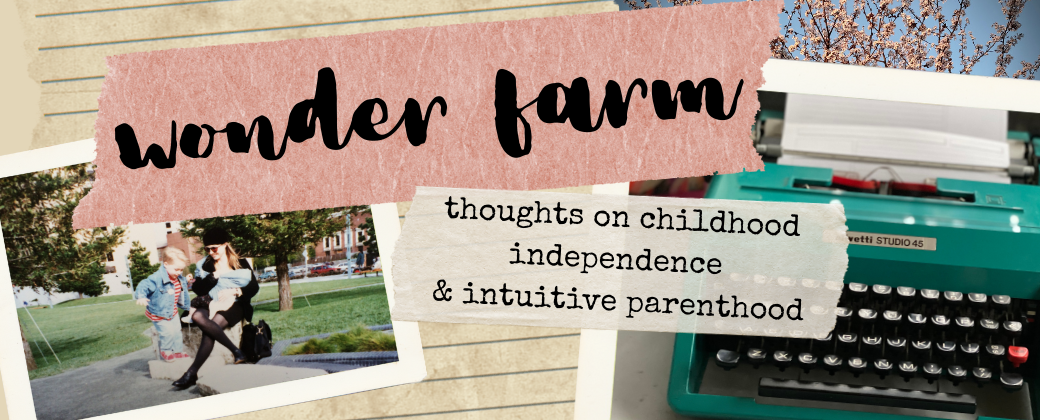Yet another post in a month-long series.

A cooperatively-transcribed story. He dictated part and wrote part himself.
“You gotta hear this,” Mr. T said to me the other day. And then he proceeded to read, “The end of the world started when a pegasus landed on the hood of my car.”
It was the first line from the last Percy Jackson book and it delighted him.
“That’s a pretty exciting first line,” I said. “Isn’t it?”
“Yup.” He grinned. And read it again.
Yet another interesting benefit to taking dictation from kids–in addition to helping them painlessly pick up the rules of grammar–is that it helps them believe they are writers from a very young age. Once they believe they are writers, they begin to think like writers. Which leads them to understand that there isn’t one way to tell a story, or to write a compelling piece of nonfiction. Which leads them to recognize that writers make choices. Which leads them to pay attention to the choices that professional writers make in their own work.
Suddenly you have a kid who notices the craft of writing. It’s a fabulous thing.
Any kid who writes might do this. But there is something about taking dictation, I think, that particularly fosters it. When you sit and take dictation from your child, you are privvy to his or her thought processes. You are present as they tinker with lines, or alter the direction of scenes, or try to figure out what comes next. And often they tell you precisely what they’re thinking.
When a child says, “I don’t know what should happen next,” you’re in an ideal position to point out that there isn’t a single solution. That writers constantly make choices as they work. You can encourage your child to brainstorm a few different possibilities. It doesn’t take long for kids to recognize that writing is pliable, and full of possibility. And that they are the masters of it all.
One day when Mr. T was beginning to dictate a story, he said, “It’s gonna be one of those stories that has to have a prologue.”
“Where did you learn the word prologue?” I wondered.
“I don’t know. Magic Tree House or something?” He wasn’t sure.
I was curious. “Why did you decide to have a prologue in this story?”
“Cause there’s a part that’s not about a character. It’s explaining to you what’s going on.”
It’s natural for kids to learn from the literature they love. Again, as their transcriber, you’re in a position to encourage this. When a child is struggling with something in a piece of writing, you might direct her to a favorite author who writes in a similar style. How might Lemony Snicket start a chapter? Or how does Jim Arnosky describe a plant? When I’m stuck in my own writing, I often flip to my own favorite writers for answers. Just reading a few pages can be all it takes to get me going again.
Once kids begin thinking this way, they start noticing what writers are doing in their work. Again, you can encourage this as you read together. I’ve written about how my kids and I are great fans of listening to audiobooks together. I often point out masterful writing as we hear it. Just a quick comment–I’m not trying to annoy them. “I love that word, titter,” I might say. Or, “Ooh, such a good first line!” My kids do it too. Sometimes we have longer discussions. “Stop the story,” T. called out the other day, as we listened to the first Artemis Fowl on disc in the car. The disc got stopped and he announced, “I don’t like Artemis Fowl.” He wasn’t talking about Artemis Fowl, the book, which he’s quite taken with; he was talking about Artemis Fowl, the character. “I like the fairies better.” And suddenly we were chatting about what makes particular characters likable in the story. It was a glorious, impromptu conversation on craft.
I don’t set out to formally discuss literature with my kids. The conversations just happen as we savor good books together. It only takes a few quick comments about what you admire in a piece of writing to inspire comments from your kids. Soon full conversations blaze forth when you least expect them.
We talk about Mr. T’s own writing the same way. After all, he’s a writer too! And after years of this sort of conversing, the sophistication of his insights routinely surprises me.
The other day as he dictated a story, he explained, “I like the beginnings of my stories to be short and not from the main character’s perspective, so it’s exciting. Then I go to a longer part that’s not as exciting when I go into the character’s head.”
Let’s see: he’s talking about pacing and perspective and intriguing leads. All tools of effective writers.
He described more about the introduction of his story. “It’s like the narrator is a ghost, so that secrets that are inside are not revealed. So stuff only happens that if you were there, you would understand.”
Something tells me that this kid will not become baffled if he takes an English class in college, and the professor starts throwing around terms like omniscient narrator and close third person. Not to mention the palpable delight T. takes right now in discussing his craft on the page.
I don’t mean to make T. out to be some sort of literary genius eight-year-old. Not at all. On the contrary, I’ve worked with dozens of kids over the years in writer’s workshops, and I’m always astounded at how quickly they take to and apply the tools of writing to their own work. Flashback. Metaphor. Second person, present tense narration. They talk about these tools; they use these tools. They think like writers because they are writers.
It’s a simple, non-formulaic formula: Write with your kids and talk about it. Read with your kids and talk about it. Help them see that both types of conversation are the same conversation.
This is a powerful compound. Remember your safety goggles. Prepare to see sparks fly.
* * *
So tell me, those of you who have been taking dictation from your kids this month–how’s it going?

I mentioned in a comment for another one of your posts that I have an expectation that Cecil write something (or I dictate) regularly, but that what she wants to write or dictate is up to her. If I didn’t have this expectation, I don’t think my suggestions for her to dictate or elaborate on something would fly. She’d rather play legos or read, for example.
Recently, after she showed me a few new drawings of her dresses and accessories for her catalog, I told her that she needed to do some kind of writing that day and said that she might consider using her drawings as inspiration for her writing. I suggested that she might want to label the dress parts or give them a name; or, she could describe them and that I would dictate her ideas. I could see by her expression that she didn’t understand what I meant by naming them or describing them. I asked her if she’d like to see a sample of a catalog that did just that.
Cecil and I checked out the J. Peterman Company website per your suggestion. (Great idea Tricia. Thanks.) She was amazed to see all the clothes were hand-drawn. The dresses had names. Better yet, that a narrative about their use made them sound very interesting. And this resulted:
The Cecilia Dress
Wear this dress to the North Pole while you study pieces of ice age mammoth bone in a little hut with a fire place that keeps going out and you have to keep re-lighting it. I designed it because I like polar bears.
One piece divided by color. Blue silk short-sleeved shirt, rounded neck, spaghetti straps and a layer of silver gauze over the bodice. A three inch white sash wraps around the waist and ties in the back with a big bow and extra flowing ribbon that drapes to the end of the dress. A black silk skirt falls to your shins. Made in U.S.A.
Sizes 6, 7, 8, 9, 10
$100
Accessories:
4 inch tall and 5 inch brim silk Top Hat with a white silk sash around the base and a silk blue rose.
Shoes: Leather silver shoes with a blue velvet inner rim.
Sizes 6, 7, 8, 9, 10
–In this case, we’ve combined fiction with non-fiction and realized that there is a lot of terminology about describing clothes that we are unfamiliar with, so I ordered a free catalog.
–EEK my comment is too long.
No comment is ever too long for me! Especially when it contains authentic kid writing!
I’m thrilled that Cecil was interested in trying this out. And, yes, look at the variety of writing included there! There’s even humor in her description of the dress! It’s always exciting, too, when kids take on a very specific type of writing and discover a whole new world of terms to play with. She already has a handle on catalogue lingo: “A black skirt falls to your shins.” I love it!
(I didn’t actually know that J. Peterman still exists. I figured you’d have to find some other catalogue to mimic. I just remember all those Seinfeld episodes with Elaine working there, and how the show made fun of the flowery clothing descriptions.)
Maybe C. will decide to share this at the writer’s workshop. It’s always neat when kids bring a variety of writing genres.
Thanks so much for sharing this, Kristin. Made my day!
Oh, wow, I want the Cecilia dress- are they still in production? 😉
Patricia,
I’ve been loving this series, but I’m wondering if you could write a little more about how you introduced dictation with each of your kids and how you’ve sustained the habit of this way of writing with them. My four-year-old daughter periodically asks me to take dictation but I’d love to do even more of it with her. My seven-year-old boy used to have me copy down his stories when he was younger but now doesn’t ask and rebuffs my offers to write down his ideas.
If you’re up for writing about it, I’d love to know more about getting started and keeping things going.
Thank you!
Okay! In my latest post I try to address some of these issues–and others. Hope there’s something helpful there.